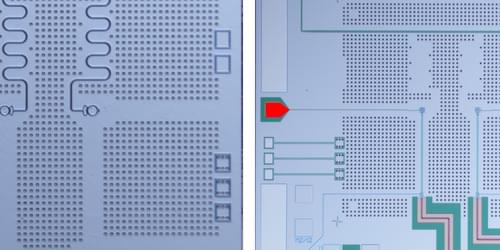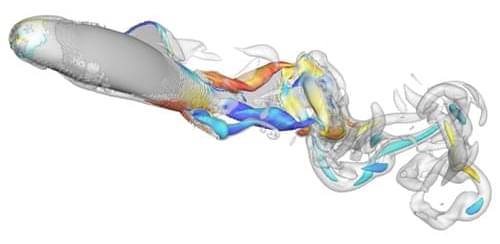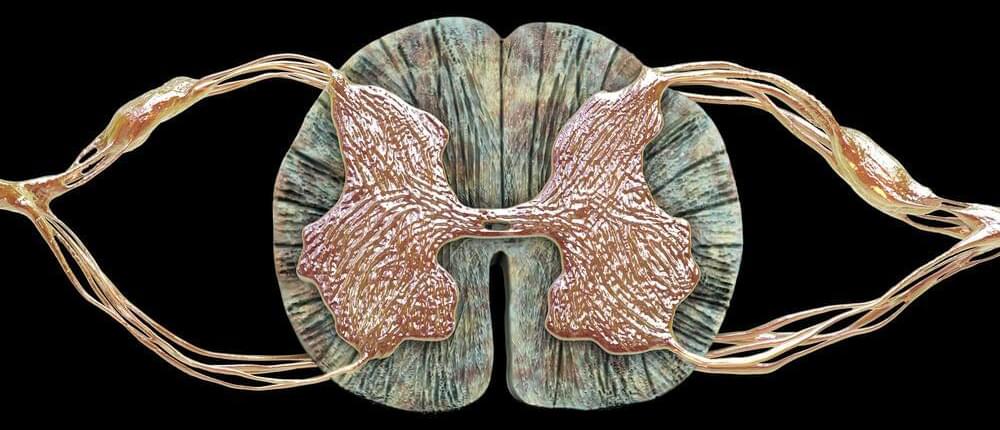Page 2620
Jul 25, 2023
AI creates a realistic video of you dancing from a single still image
Posted by Omuterema Akhahenda in category: robotics/AI
An artificial intelligence trained on TikTok videos could help you take part in dance trends without moving a muscle.
Jul 25, 2023
Error Rate Reduced for Scalable Quantum Technology
Posted by Saúl Morales Rodriguéz in categories: computing, quantum physics
A scalable system for controlling quantum bits demonstrates a very low error rate, which is essential for making practical devices.
A major obstacle to the development of practical quantum computers is the difficulty of scaling up—making a device with large numbers of quantum bits (qubits) that also gives accurate results in the presence of environmental noise. Now researchers report a significant improvement in the accuracy of a technology that is already known to be much easier to scale up than conventional techniques [1]. This alternative technology uses units of magnetic flux called flux quanta to control conventional superconducting qubits. The reduction in the error rate came from physically separating the control circuits from the qubits. With further refinement, the flux-quanta technology could provide a superior pathway to practical quantum computation.
Many current efforts to carry out quantum logic operations—the basic units of computation—use short microwave pulses to control the qubits. Currently, however, this technology is difficult to scale up beyond 1,000 qubits. But the presence of environmental noise requires error-correction methods that rely on large numbers of qubits, perhaps a million or more, for an effective error-correcting system that performs useful computations, according to some estimates.
Jul 25, 2023
Wind Tunnel Experiments Challenge Turbulence Theory
Posted by Saúl Morales Rodriguéz in categories: energy, information science
Measurements conducted over an unprecedented span of conditions uncover universal behavior, but not the kind that theorists expected.
Turbulence is a mesmerizing, chaotic state of fluid motion. It occurs in natural and artificial settings whenever the Reynolds number (quantifying the relative size of inertial to viscous forces in the flow) is large. Through nonlinear coupling, kinetic energy cascades from large scales to ever smaller scales (Fig. 1) until it is dissipated by viscous effects. The fluctuations excited during this process play a crucial role in a diverse range of problems, including planetesimal formation [1], rain initiation in clouds [2], and heat transport within oceans [3]. Remarkably, a new experimental study by Christian Küchler of the Max Planck Institute for Dynamics and Self-Organization in Germany and co-workers provides compelling evidence that current theoretical models for how the fluctuations are distributed across the scales are missing some important ingredients [4].
Turbulent flows are complex. Quantitative predictions of their properties that are derived directly from the Navier-Stokes equation, without ad hoc assumptions, are accordingly scarce. Most theoretical approaches have perforce been phenomenological, the most famous being Andrey Kolmogorov’s groundbreaking 1941 theory, nicknamed K41 [5]. This mean-field theory assumes that the multiscale properties of the turbulent fluctuations are governed by the average cascade of kinetic energy passing through the scales and by the fluid viscosity. In K41 Kolmogorov went on to propose the existence of an inertial range, which corresponds to an intermediate range of scales over which viscous forces could be ignored relative to inertial forces and where the details of the large-scale forcing are unimportant.
Jul 25, 2023
Fish Are Boosted by Cooperating Fin Currents
Posted by Saúl Morales Rodriguéz in category: computing
As fish wriggle, they create a complex push–pull pattern in the water that propels them forward. Many studies have shown how the motion of a fish’s tail forms a vortex around its leading edge that provides thrust; however, it has been difficult to capture how the water flow around other parts of the fish interacts with this vortex to impact the overall propulsion. Jiacheng Guo at the University of Virginia and colleagues recently demonstrated how different fins create currents that can constructively interact to improve swimming efficiency [1].
Guo and colleagues studied how the flow around the lower back—or anal—fin interacts with the flow around the tail—or caudal—fin. First, they took a high-resolution video of a swimming rainbow trout and created a computational fluid dynamics model to accurately reproduce the fish’s motion and the water currents that it induced. Then they modified the anal fin in the model to see how this would change the pattern of water flow around the trout and affect the forward thrust.
The researchers found that the anal fin increases propulsion in two ways. It creates a vortex that stabilizes and strengthens the caudal-fin vortex, and it helps maintain a pressure difference across the fish’s body that reduces drag. Changes to the size or position of the anal fin decreased the swimming efficiency, demonstrating that the natural fish physiology is optimal.
Jul 25, 2023
Banking Sector Targeted in Open-Source Software Supply Chain Attacks
Posted by Saúl Morales Rodriguéz in categories: cybercrime/malcode, finance
Cybersecurity researchers said they have discovered what they say is the first open-source software supply chain attacks specifically targeting the banking sector.
“These attacks showcased advanced techniques, including targeting specific components in web assets of the victim bank by attaching malicious functionalities to it,” Checkmarx said in a report published last week.
“The attackers employed deceptive tactics such as creating a fake LinkedIn profile to appear credible and customized command-and-control (C2) centers for each target, exploiting legitimate services for illicit activities.”
Jul 25, 2023
Apple Rolls Out Urgent Patches for Zero-Day Flaws Impacting iPhones, iPads and Macs
Posted by Saúl Morales Rodriguéz in categories: mobile phones, security
Apple has rolled out security updates to iOS, iPadOS, macOS, tvOS, watchOS, and Safari to address several security vulnerabilities, including one actively exploited zero-day bug in the wild.
Tracked as CVE-2023–38606, the shortcoming resides in the kernel and permits a malicious app to modify sensitive kernel state potentially. The company said it was addressed with improved state management.
“Apple is aware of a report that this issue may have been actively exploited against versions of iOS released before iOS 15.7.1,” the tech giant noted in its advisory.
Jul 25, 2023
Critical Zero-Days in Atera Windows Installers Expose Users to Privilege Escalation Attacks
Posted by Saúl Morales Rodriguéz in category: security
Zero-day vulnerabilities in Windows Installers for the Atera remote monitoring and management software could act as a springboard to launch privilege escalation attacks.
The flaws, discovered by Mandiant on February 28, 2023, have been assigned the identifiers CVE-2023–26077 and CVE-2023–26078, with the issues remediated in versions 1.8.3.7 and 1.8.4.9 released by Atera on April 17, 2023, and June 26, 2023, respectively.
“The ability to initiate an operation from a NT AUTHORITY\SYSTEM context can present potential security risks if not properly managed,” security researcher Andrew Oliveau said. “For instance, misconfigured Custom Actions running as NT AUTHORITY\SYSTEM can be exploited by attackers to execute local privilege escalation attacks.”
Jul 25, 2023
New ALS Therapeutic Strategy Targets mRNA and Protein Distribution
Posted by Shubham Ghosh Roy in categories: biotech/medical, neuroscience
Maintenance of mRNA and protein localization in motor neurons is a potential therapeutic avenue for Amyotrophic lateral sclerosis (ALS), report researchers from The Francis Crick Institute and the University College London (UCL). A new study shows how the extensive changes in mRNA and protein in ALS motor neurons are linked to mutations in an ATPase called VCP. These mutations may contribute to the mislocalization of RNA binding proteins (RBPs) that tend to clump together and the redistribution of the mRNAs they are bound to. Inhibition of VCP partly restored mRNA and protein localization and other ALS phenotypes. These results show how RBP mislocalization and mRNA redistribution in motor neurons are linked to ALS and how VCP inhibition could be used as a treatment.
The study “Nucleocytoplasmic mRNA redistribution accompanies RNA binding protein mislocalization in ALS motor neurons and is restored by VCP ATPase inhibition” was published today in Neuron.
“For the patients I see, it’s devastating that there aren’t yet impactful treatments available for ALS,” said Rickie Patani, PhD, senior group leader of the Human Stem Cells and Neurodegeneration Laboratory at the Crick, professor at UCL, and consultant neurologist at the National Hospital for Neurology. “This research represents a shift in our thinking about what causes ALS—it doesn’t involve abnormal movement of just a few proteins, but the abnormal localization of hundreds of proteins and mRNAs. This opens new avenues for research and potential therapies.
Jul 25, 2023
Solid Strategies for CAR T-Cell Immunotherapies
Posted by Shubham Ghosh Roy in category: futurism
With new off-the-shelf allogeneic options and armoring approaches, developers hope to target solid tumors more safely and efficaciously.


















